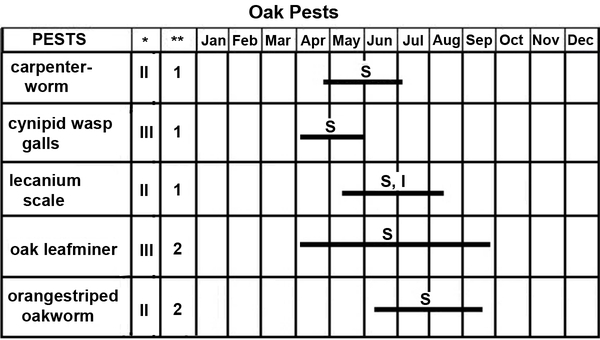Caution
This information was developed for North Carolina and may not apply to other areas.
Please click on the thumbnail to enlarge it or jump to the last section to view an accessible version of the table in HTML format.
Table Legend
* Degree of importance of pest: I = Important pest, high probability of occurrence; II = Treat as needed; III = Occasional pest, treat when detected.
** Number of applications needed for most effective control. It is usually best to wait 10 to 14 days between applications in cool weather and 7 to 10 days between applications in warm weather.
I = Pesticide injection; S=Spray application.
Other Resources
- Carpenterworm. Frank, S. et al. 2019 (revised). Entomology Insect Notes, NC State Extension Publications.
- Galls on Oaks. Frank, S. et al. 2019 (revised). Entomology Insect Notes, NC State Extension Publications.
- Horticultural Oils for Ornamental Plants. Frank, S. et al. 2023 (revised). Entomology Insect Notes, NC State Extension Publications.
- Lecanium Scale Insects. Frank, S.and J. R. Baker. 2019 (revised). Entomology Insect Notes, NC State Extension Publications.
- Orangestriped Oakworm. Frank, S.and S. Bambara. 2019 (revised). Entomology Insect Notes, NC State Extension Publications.
- Extension Plant Pathology Publications and Factsheets
- Horticultural Science Publications
- North Carolina Agricultural Chemicals Manual
For assistance with a specific problem, contact your local N.C. Cooperative Extension Center.
This Insect Note has not been peer reviewed.
The Oak Pest Management Calendar
The Oak Pest Management Calendar gives approximate dates for pest emergence.
| Pests | Degree of Importance of Pest* | Number of applications** | Jan | Feb | Mar | Apr | May | Jun | Jul | Aug | Sep | Oct | Nov | Dec |
|---|---|---|---|---|---|---|---|---|---|---|---|---|---|---|
| carpenter-worm | II | 1 | Spray Application | Spray Application | ||||||||||
| cynipid wasp galls | III | 1 | Spray Application | Spray Application | ||||||||||
| lecanium scale | II | 1 | Spray Application or Pesticide injection | Spray Application or Pesticide injection | Spray Application or Pesticide injection | Spray Application or Pesticide injection | ||||||||
| oak leafminer | III | 2 | Spray Application | Spray Application | Spray Application | Spray Application | Spray Application | Spray Application | ||||||
|
orangestriped oakworm |
II | 2 | Spray Application | Spray Applications | Spray Application | Spray Application |
* Degree of importance of pest: I=Important pest, high probability of occurrence, II=Treat as needed: III=Occasional pest, treat when detected. ↲
** Number of applications needed for most effective control. It is usually best to wait 10 to 14 days between applications in cool weather and 7 to 10 days between applications in warm weather. ↲
Publication date: Jan. 29, 2019
Reviewed/Revised: Nov. 9, 2023
N.C. Cooperative Extension prohibits discrimination and harassment regardless of age, color, disability, family and marital status, gender identity, national origin, political beliefs, race, religion, sex (including pregnancy), sexual orientation and veteran status.

